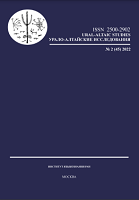Именная морфология в памятнике марийской письменности… «Начатки христианского учения...» (1839/1841). Падеж
Noun morphology in the monument of Mari writing “The beginnings of Christian doctrine ...” (1839 / 1841). The case
Author(s): Maria A. KlyuchevaSubject(s): Morphology, Historical Linguistics, Finno-Ugrian studies
Published by: Институт языкознания Российской академии наук
Keywords: Finno-Ugric languages; Mari language; Volga dialect of the Mari language; written monuments; noun morphology; historical dialectology; accentology;
Summary/Abstract: This article continues the analysis of the Mari text of the book “The Beginnings of Christian doctrine ...”, published in Kazan in 1841. Previously (see [Klyucheva 2021]), the verb morphology (conjugation) in it was described. This work describes the noun morphology in “The Beginnings…” — the case system of nouns in the singular. In continuation of this work, we plan to consider the categories of number and possession. The case system in “The Beginnings…” includes all the 9 cases of the modern standard Mari (Meadow-Eastern) language and also abessive and ablative. The presence of the causative (case) with the indicator -lanen is questionable: it occurs in “The Beginnings…” in a single example with a pronoun. The analysis of noun morphology in “The Beginnings…” is made in comparison with the standard Mari (Meadow-Eastern) language and Meadow dialects. Its specificity lies primarily at the phonetic level: in the vocalism of unstressed syllables and the stress system. The system of vowels includes labial reduced u and ü. They are expressed in “The Beginnings…” by the letters о, у, ю, and are located on the border between the stem and the case affix (after labial vowels in the stem). In the standard language, only the non-labial reduced vowel ǝ̂ occurs in this position. Such vowel harmony in the language of “The Beginnings…” corresponds to the western subdialects of the Meadow dialect, especially the Volga subdialect. As regards the stress system, in “The Beginnings…” in the comitative, dative, ablative, partly in the lativе the stress is kept on the same syllable as in the nominative, while in the literary norm and in modern Meadow dialects all these case suffixes are under stress (only in the dative is the stress fluctuation allowed). This indicates changes in the system of stresses in the Meadow dialect since the creation of the monument. The article also shows examples of non-standard use of case forms (mainly inessive, accusative and genitive). They may reflect some poorly studied functions of cases in Meadow dialects. The results of the study of the case correlate with the previously obtained conclusions about the Volga dialect as the dialectal basis of this written monument. It reflects not only the modern, but also the historical features of this dialect.
Journal: Урало-алтайские исследования
- Issue Year: 2022
- Issue No: 02 (45)
- Page Range: 34-57
- Page Count: 24
- Language: Russian

